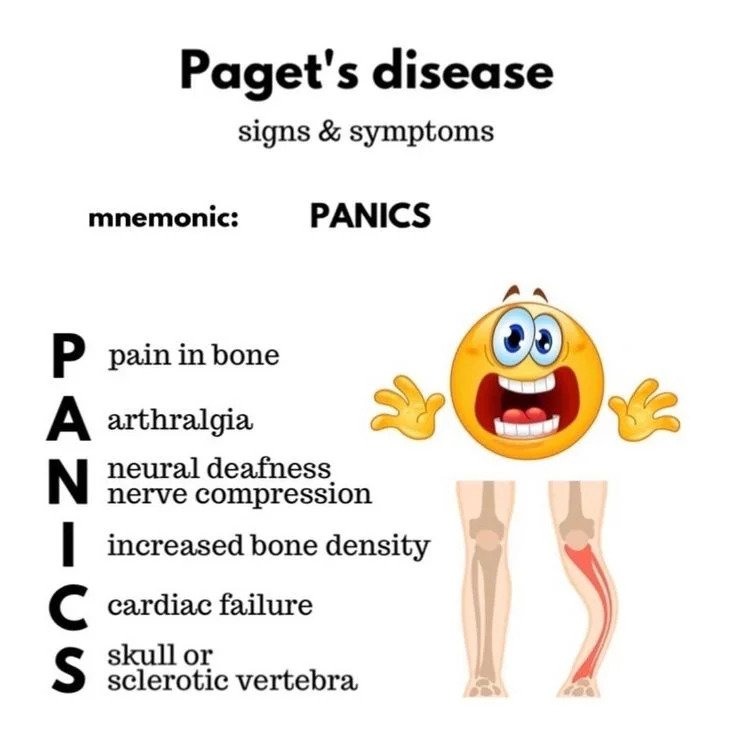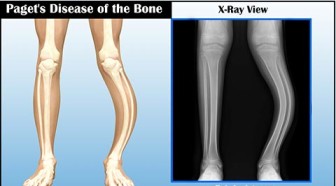Table of Contents
TogglePaget’s disease
Paget’s disease of bone also known as osteitis deformans is a chronic disease of the skeleton characterized by focal excessive bone remodeling. and is the second most common bone disease worldwide after osteoporosis.
Paget’s disease of bone is a disorder in which there’s a lot of bone remodeling that happens in some regions of the bone. Typically there’s excessive bone resorption followed by excessive bone growth, and that leads to skeletal deformities and potential fractures.
Pathophysiology of Paget’s Disease
In normal bone, there is a normal process called remodeling. Bone is absorbed and then reformed in response to the normal stresses on the skeleton.
- Osteoclasts: cells that absorb bone.
- Osteoblasts: cells that make new bone.
In Paget’s disease, osteoclasts are more active than osteoblasts. This means that there is more bone absorption than normal. The osteoblasts try to keep up by making new bone, but they overreact and make excess bone that is abnormally large and deformed.
Pathophysiology occurs in 3 stages, ie
- Osteolytic Phase
- Mixed Osteoclastic – Osteoblastic Phase
- Osteoblastic Phase.
Osteolytic phase, and as lytic mean destruction , So osteolytic phase presents with osteoclasts that destroy the bone and this destruction of bone results in formation of pits in the Bony matrix that are called resorption pits and these osteoclast will be visible as multinucleated large size cells.
Mixed (Osteoclastic – Osteoblastic) Phase, In the phase, there is both destruction as well as formation of new bone, where osteoclasts are destroying while osteoblasts are forming a new bone. Osteoblasts do not form enough bone compared to what osteoclasts are destroying.
Osteoblastic Phase. In this phase, there is excessive bone formation, and this excess quantity is in form of mosaic pattern of lamellar bone( jigsaw puzzle appearance)
Causes of Paget’s Disease
The causes of Paget’s disease are still unknown, idiopathic. But its thought to be a combination of environmental and genetic factors.
Risk Factors;
- Age; common in elderly.
- Viral; Paget’s disease may be caused by a slow virus infection, such as respiratory syncytial virus, and the measles virus.
- Genetics. In around 15-40% of affected patients had a first-degree relative with Paget disease.
- Autoimmune, connective tissue, and vascular disorders are also rick factors.

Signs and Symptoms of Paget’s Disease
- Bone Pain – commonly affected areas are pelvis, spine, skull, shoulders, and legs
- is usually dull or aching pain
- it is felt deep within the affected part of the body
- the pain is constant and is at its worst at night
- affected area may also feel warm
- Joint pain, stiffness, and swelling -especially in the hips, back, and knees
- Nerve Problems
- pain travelling from the spine to the legs
- pain travelling from the neck to arms and chest
- numbness or tingling in the affected limbs
- partial loss of movement in the affected limbs
- problems in balance
- loss of bladder or bowel control
- Enlargement and bowing of femurs and lower legs
- Enlargement of the skull around the forehead
Skull involvement may manifest these symptoms:
- Development of hearing loss
- Loss of vision
- Hydrocephalus
- Somnolence (drowsiness) due to vascular steal syndrome of the skull.
Diagnosis / Investigations.
- X-rays – usually done to diagnose Paget’s disease. Bones may appear larger, denser, and also have a deformed shape
- Blood tests – may reveal elevated levels of the alkaline phosphatase enzyme with normal calcium, phosphate, and aminotransferase levels in an elderly patient are suggestive of Paget’s disease
- Bone scan – may reveal the severity of abnormalities in the bones
- Urine tests – Urinary Hydroxyproline is found to be elevated
Treatment and Management of Paget’s Disease
There is no cure for Paget’s disease and no way to reverse its effects on bone.
Aims;
- To relieve bone pain and prevent the progression of the disease
- Treatment focuses on the relief of symptoms
- Prevention of future complications
Non-pharmacological Therapy. Physical therapy for the improvement of muscle strength and pain relief in some types of pain.
- While there are no known ways to prevent Paget’s disease from occurring, eating a healthy diet with sufficient calcium and vitamin D, and getting regular exercise, are important components in maintaining skeletal health and joint mobility.
Pharmacological Treatment. The medications used in the management of Paget’s disease include:
- Biphosphonates (check more on osteoporosis)– suppress or reduce the resorption of bone by osteoclasts. Currently, there are 6 approved bisphosphonates for the treatment of Paget’s disease. Prior to the start of the therapy, patients undergo a regimen of calcium and vitamin D every day for two weeks. This is for the reduction of risk of low blood calcium after infusions. This drug is not indicated for those with low blood calcium or those with vitamin D deficiency and those with compromised renal function. Calcium supplements need to be taken with bisphosphonates to reduce the risk of hypocalcemia.
- Calcitonins. They decrease symptoms of bone pain, reduce inflammation over bones, improve neurological complications, and promote healing of lytic lesions. Calcitonins are used mostly by patients who cannot tolerate bisphosphonates.
- Pain Management. Pain due to Paget’s disease may be the result of bone deformity, arthritic, or neurological complications. Acetaminophen, NSAIDs, are used for the management of pain associated with Paget’s disease.
- Surgery. Surgical procedures used to treat fractures, malalignment, or arthritis in patients with Paget’s disease.
- Internal fixation. This is used to treat fractures in the bone affected by the disease. In internal fixation, bone fragments are first repositioned into their normal alignment, then immobilized through the use of screws, wires, pins, or metal plates attached to the outside of the bone.
- Osteotomy. This can help relieve pain and restore alignment to weight-bearing joints especially the hip and knee. The procedure involves the removal of a wedge of bone near the damaged joint in order to shift weight to a healthier, more stable part of the joint.
- Total joint replacement. In this procedure, parts of a damaged or arthritic joint are removed and replaced with a metal, ceramic, or plastic device called a prosthesis. The prosthesis is designed to replicate the movement of a healthy joint.
Nursing Diagnosis
- : Acute pain related to joint inflammation secondary to Paget’s disease, as evidenced by pain score of 10 out of 10, guarding sign on the affected fingers, restlessness, and irritability
- Activity intolerance related to joint inflammation and pain secondary to Paget’s disease, as evidenced by pain score of 8 to 10 out of 10, fatigue, disinterest in ADLs due to pain, verbalization of tiredness and generalized weakness.
- Deficient Knowledge related new diagnosis of Paget’s disease, as evidenced by patient’s verbalization of “I want to know more how to manage my illness.”
Nursing Interventions.
- Assess the patient’s activities of daily living, as well as actual and perceived limitations to physical activity. Ask for any form of exercise that he/she used to do or wants to try.
- Encourage progressive activity through self-care and exercise as tolerated. Explain the need to reduce sedentary activities such as watching television and using social media in long periods. Alternate periods of physical activity with 60-90 minutes of undisturbed rest.
- Administer analgesics as prescribed prior to exercise/ physical activity. Teach deep breathing exercises and relaxation techniques. Provide adequate ventilation in the room.
- Refer the patient to physiotherapy / occupational therapy team as required. This is to provide a more specialized care for the patient in terms of helping him/ her build confidence in increasing daily physical activity.
- Assess the patient’s readiness to learn, misconceptions, and blocks to learning (e.g., denial of diagnosis or poor lifestyle habits).
- Inform the patient the details about the prescribed medications (e.g., drug class, use, benefits, side effects, and risks) to treat acute pain. Ask the patient to repeat or demonstrate the self-administration details to you.
- If the patient is for surgery, explain the surgical procedure related to Paget’s to the patient and caregiver. The doctor may recommend surgery to resolve unbearable joint pain due to Paget’s disease.


It’s good
Thank you
Thanks
Easily understandable